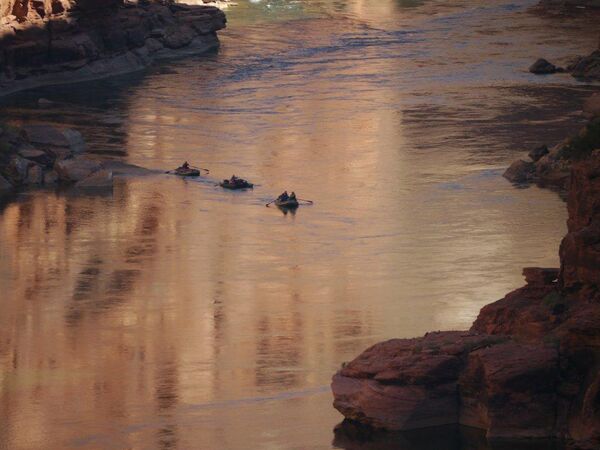Staying Together
Some trips will decide to use a boat order on the river. If a boat order is used then it is important to be able to catch an eddy to maintain the boat order. This may just be a sliding eddy to allow a boat to slow down. The point boat is any boat that knows where lunch is, where the camp for the night is, and where the pull-in for scouting rapids and or visiting attraction sites is. It should have two people to make it easier for a person to jump out and secure the line and prepare for the following boats. The sweep boat should have the satellite phone if the group has one, and the major first aid kit. The sweep boat should stay behind all persons who may have stopped to hike. It's also helpful if the sweep boat has some knowledge of the river.
A traditional boat order is mama duck baby duck. This is often thought of for teaching. In this case the strongest boat (teacher) leads and the following boats follow one after the other. In this case the boats are in a fixed order, never passing another boat. The rule here is always to keep the boat behind you in sight and to catch an eddy if not. There have been situations where a boat has sprung a hole and has to pull over for a repair. If the next boat does not appear for a while then it may be necessary to send someone upstream to find out what happened.
A boat order for expert boaters on a continuous river is the leapfrog order. In this case the lead boat catches an eddy and boat scouts and points out the next eddy to the second boat. That boat passes the first boat and catches the eddy. This ensures that the group is tightly spaced so that if anyone gets into trouble there is someone nearby.
It is important to minimize the distance between where a boat can get into trouble and where the rescue boats are located. For this reason when the first boat starts down a rapid another boat should follow at a reasonable spacing in case the first boat gets into trouble. So when the lead boat decides to proceed (possibly deciding a scout is not necessary) they are also making the decision for the second boat which may not be located where they can see what is ahead. If the first boat feels confident in themselves but does not want to make the decision for the second boat then they need to wave them off. This is called a naked lead. An example may be a group with a safety kayaker that runs the rapid as a naked lead to set up safety.
Where should the leader of the group be in the boat order? If they are in the first boat how do they know if someone is in trouble and dropping back or stopping? If they are the sweep boat then who is figuring the line through the rapids? From outdoor leadership (hiking, boating, etc.) there is an answer. The leader of the group should be constantly moving from the lead to the sweep and checking to make sure that everyone is doing okay.
One of the common complaints from commercial guides is that self-guided groups are strung out a long distance along the river. This is often as a result of self-guided groups having a larger number of boats and using a fixed boat order. One measure of wilderness experience is the number of encounters per day. But if an encounter can occur over a mile or an hour then it is different than a quick encounter. For this reason self-guided groups should stay close together to minimize the impacts on other groups.
So think about what is ahead for the day. If stopping to hike or finding a camp then perhaps a point boat needs to be designated. When running a rapid decide where the safety boats should be located and then figure out how they get there safely. Maybe a group wants to have the most experienced boat in the lead when running rapids and they agree to catch an eddy so that boat can go first. If it is a small rapid they may decide to go ahead.
John Wesley Powell's group did not stay together. At Separation Rapid they split up. The group that stayed on the river did not wait to make sure the hiking group was okay. They could have set up a signal using a fire or waiting a fixed number of days to make sure the hiking group found a route out of the canyon. When John Wesley Powell got off the river he made little effort to find out what happened to the hiking group. There is evidence that there was friction in the group exacerbated by the length of the canyon, scarcity of food, etc. and the separation was not just a physical separation of the group.
Lewis and Clark travelled two years through unknown territory facing just as many or more hardships. They allowed Sacagawea, a Lemhi Shoshone, to help them over thousands of miles. When a decision had to be made on the location of one of their winter forts Clark's slave York was allowed to vote. They did not lose a single person. Despite all their hardships they stayed together as a group including Sacagawea and York.
Is your group like Powell's or Lewis and Clark's? Remember it is not about yourself. The objective is get the group safely down the river. It is easy to get excited at Lava Falls and only think about your line but have you made sure that everyone else in the group knows what they are supposed to be doing and is ready?
Here's a photo of group staying together... enjoy!
Click here to return to the River Safety page.
